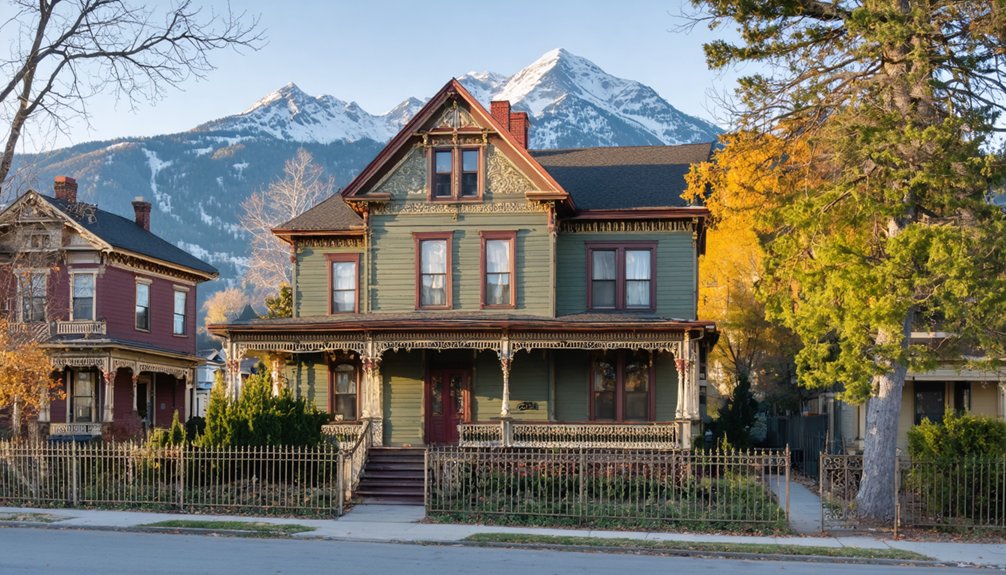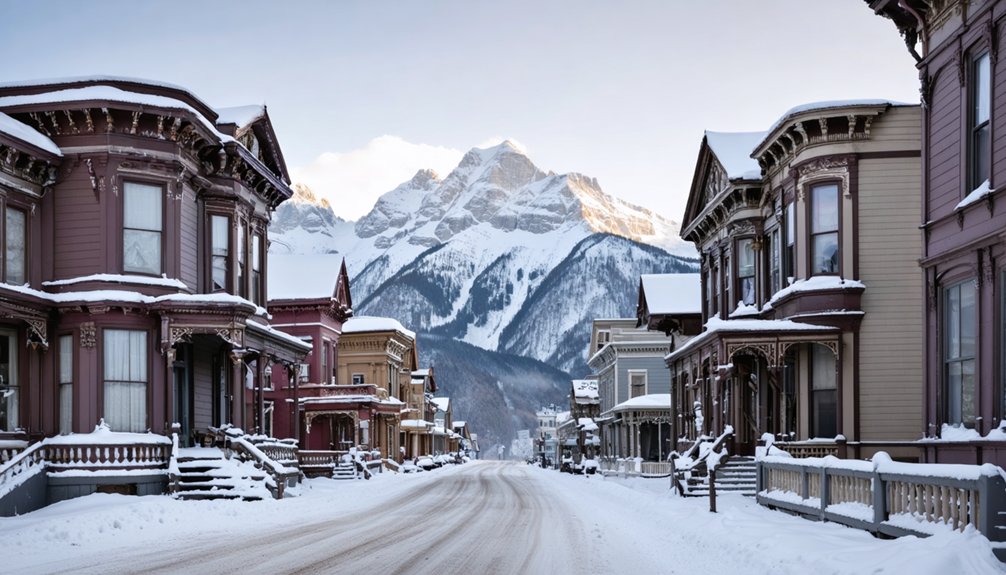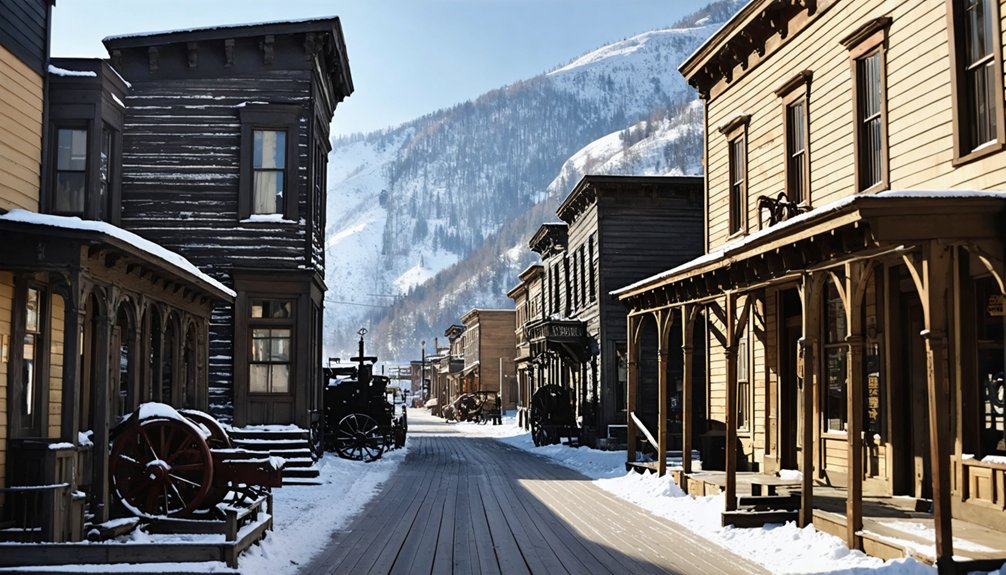Georgetown isn’t actually a ghost town—it successfully transformed from a booming 1860s mining settlement into a preserved National Historic Landmark District. Unlike abandoned mining towns, Georgetown pivoted to heritage tourism after the 1893 Silver Crash. You’ll find over 200 Victorian structures, historic businesses operating since 1883, and the ghostly legend of Edward Bainbridge. This “Silver Queen of Colorado” reveals how communities can thrive beyond economic collapse.
Key Takeaways
- Georgetown avoided becoming a ghost town by preserving over 200 Victorian-era structures through conservation efforts.
- After the 1893 Silver Crash, Georgetown pivoted from mining to heritage tourism and cultural preservation.
- Designated a National Historic Landmark District in 1966, Georgetown maintains authentic architectural heritage from its mining heyday.
- The town features ghostly legends including Bainbridge’s spirit, who was lynched after killing James Martin in a poker dispute.
- Historic attractions like the Georgetown Loop Railroad, Hamill House Museum, and Hotel de Paris showcase the town’s mining legacy.
The Birth of a Mining Town: Pike’s Peak Gold Rush Origins
Although gold had been sporadically reported by fur trappers and mountain men as early as 1806, the foundations of Georgetown’s existence can be traced to the broader Pike’s Peak Gold Rush that transformed northeastern Colorado in the late 1850s.
From pioneer reports to Georgetown’s birth, the Pike’s Peak Gold Rush forever reshaped Colorado’s mountain landscape.
The rush began in earnest when William Greene Russell’s party discovered placer mining opportunities near Dry Creek in 1858, igniting regional interest.
You’d have witnessed an extraordinary migration as 100,000+ “Fifty-Niners” flooded the region by 1859, many escaping the 1857 financial panic that devastated the Midwest.
Prospecting techniques evolved quickly as settlements emerged along the South Platte and Clear Creek. Denver, Boulder, and other mining camps materialized almost overnight, their existence tied to the rallying cry “Pikes Peak or Bust!”
Georgetown emerged as one of several important mining centers that continued to thrive while many early settlements became ghost towns after their gold deposits were depleted.
This unprecedented population surge ultimately forced the federal government to establish Colorado Territory in 1861.
John H. Gregory’s discovery of gold in Gregory Gulch in January 1859 prompted miners to push deeper into the mountains in search of richer deposits.
Silver Queen of Colorado: The Boom Years
Standing majestically amid the Rocky Mountains, Georgetown earned its moniker “Silver Queen of Colorado” in 1879 when its silver mining operations reached unprecedented prosperity.
You’ll find that thousands of mines dotted the surrounding mountains after James Huff’s 1864 discovery, transforming a nascent settlement into a sophisticated community of nearly 5,000 residents by the 1880s. The town’s prosperity supported numerous businesses including hotels, banks, and even an opera house by the peak of the silver boom.
Georgetown’s evolution from rough mining camp to refined town featured impressive establishments like Hotel de Paris and the Hamill House, tangible evidence of the immense wealth extracted from silver-laden mountains. The rich silver ore discovered on Mount McClellan contributed significantly to Georgetown’s reputation as a mining powerhouse.
Silver’s Glittering Promise
Georgetown’s transformation from a modest gold-seeking outpost to the “Silver Queen of the Rockies” began with an ironic twist of fate—the silver ore initially discovered alongside gold in 1859 was largely ignored by early prospectors fixated on the more immediately valuable yellow metal. The town’s silver mining industry truly emerged in 1864 when gold mining diminished and the Griffith brothers departed. At its peak during the 1870s boom period, Georgetown reached impressive heights with a thriving population of up to 10,000 residents working in the silver district.
Wealth Amid Mountain Peaks
The silver that early prospectors once overlooked soon became Georgetown’s lifeblood, ushering in decades of prosperity that would cement the town’s legacy as the “Silver Queen of Colorado.”
When the rich silver deposits were fully recognized in 1864, they sparked a mining revolution that transformed this small mountain settlement into a thriving economic hub. Georgetown’s growth was accelerated by the Bland-Allison Act which dramatically increased demand for silver mining operations throughout Colorado. The nearby town of Silver Plume, incorporated in August 19, 1880, developed alongside Georgetown as miners sought the high-grade silver ore that gave the settlement its distinctive name.
From Boomtown to Historic Treasure: Georgetown’s Evolution
You’ll notice that Georgetown’s shift from mining prosperity to economic decline didn’t result in abandonment like many other Colorado mining settlements.
Unlike typical ghost towns, Georgetown preserved over 200 Victorian-era structures, maintaining its historic character through deliberate conservation efforts.
The town’s ability to pivot from extractive industry to heritage tourism represents a remarkable case study in adaptive community resilience during the post-mining era. This transformation includes embracing local history, even the darker aspects like the Bainbridge lynching that now contribute to the town’s ghostly reputation.
Visitors can experience this preserved history through attractions like the Hotel de Paris, built in 1875 and now operating as a museum under the National Trust for Historic Preservation.
Riches to Preservation
Once a thriving silver mining community that rose to prominence in the 1860s, Georgetown presents an unusual narrative among Colorado’s mining settlements—a boomtown that never truly became a ghost town.
Unlike countless settlements that vanished after economic collapse, Georgetown’s shift from riches to preservation illustrates remarkable resilience amid economic challenges.
The town’s cultural significance emerges through:
- Preservation of over 200 authentic Victorian structures dating to the silver boom
- Continuous operation of historic businesses like the Nisel and Anderson grocery (est. 1883)
- Transformation of the mining economy to heritage tourism after the 1893 silver crash
- Community-driven restoration efforts maintaining architectural integrity while creating economic opportunity
You’ll find Georgetown’s survival particularly compelling—a living reflection of how preservation can transform potential abandonment into cultural and economic rebirth.
Silver Empire’s Afterlife
How does a former mining colossus adapt when its economic foundation crumbles? Georgetown’s trajectory illustrates the resilience of western frontier communities facing economic decline. Following the 1893 Silver Crash, the population plummeted from 5,000 to a fraction of its former size as mine closures displaced approximately 2,000 workers.
Rather than surrendering to obsolescence, Georgetown pivoted toward cultural preservation of its substantial architectural heritage. The town’s opera house, banks, and historic hotels—symbols of vanished prosperity—became assets in a new economy.
What distinguishes Georgetown from typical ghost towns is this deliberate transformation from industrial hub to living museum. The Georgetown-Silver Plume Mining District now functions as an interpretive landscape where industrial remnants, from Bruckner furnace technology to ball mills, document Colorado’s silver mining evolution while supporting heritage tourism.
Haunted Histories: The Ghost of Edward Bainbridge
Among Georgetown’s most infamous spectral residents, the ghost of Edward Bainbridge stands as a chilling symbol to the town’s violent frontier past.
A haunting echo of frontier violence, Bainbridge’s restless spirit reminds visitors of Georgetown’s unforgiving past.
You’ll discover his tale intertwines with Georgetown’s haunted lore, beginning with his lynching after shooting James Martin during a poker dispute—making him the town’s first recorded death.
Bainbridge’s spectral manifestations have been documented across several locations:
- Point of Rocks, where witnesses report concentrated spiritual energy
- Above Guanella Pass, inducing inexplicable dread in travelers
- The former Nickel Saloon site, now validated by psychic Peter James
- Near his exhumed remains, which were controversially displayed in a local doctor’s home
This lingering presence exemplifies how Georgetown’s lawless past persists in contemporary ghost sightings, reflecting the unresolved tensions of America’s post-Civil War frontier justice.
Architectural Heritage: Preserved Victorian Splendor

While Georgetown’s ghostly residents may haunt its shadows, the town’s most tangible connection to the past shines through its remarkably preserved Victorian architecture.
You’ll discover an impressive array of Victorian styles—from ornate Queen Anne structures with their decorative towers and elaborate woodwork to the distinctive mansard roofs of Second Empire buildings like the Cornish House.
The 1966 National Historic Landmark District designation catalyzed robust historic preservation efforts.
Organizations like Historic Georgetown, Inc. and The Georgetown Trust have meticulously maintained architectural authenticity since the 1970s.
The Hamill House Museum exemplifies this commitment, showcasing period-appropriate gas lighting, walnut woodwork, and auxiliary structures that transport you to the silver mining boom era.
Despite mountain climate challenges, Georgetown’s Victorian treasures endure, proof of community-driven conservation.
Mining Legacy: Tunnels, Trails and Treasures
Beneath Georgetown’s picturesque Victorian façade lies a complex network of tunnels, trails, and treasures that embodies the town’s rich mining heritage.
Though founded on gold discoveries in 1859, Georgetown rapidly evolved into a silver mining hub with nearly 40 operational mines before economic collapse ended the boom.
Today, you can experience this metallurgical legacy through:
- The Lebanon and Everett tunnel tours, where you’ll witness authentic silver veins in passages maintained at a constant 44°F.
- The historic 7:30 Mine Trail dating from 1872, connecting you directly with miners’ daily routes.
- The reconstructed Georgetown Loop Railroad, an engineering marvel that once transported ore through challenging mountain terrain.
- Meticulously restored mining artifacts and buildings, including blacksmith shops and managers’ offices, preserved through labor-intensive restoration efforts mirroring 19th-century techniques.
Winter in the Mountains: Georgetown’s Seasonal Character

When the mountain air turns frigid and snow blankets the historic streets, Georgetown transforms into a quintessential alpine winter wonderland characterized by extreme temperatures and remarkable snowfall patterns.
You’ll experience bitter cold, with January lows near 9°F (-13°C) and a staggering annual snowfall of 177 inches—six times the national average.
Despite these seasonal challenges, Georgetown’s winter character offers unique opportunities. The town averages 247 sunny days annually, with exceptional visibility of 27 miles even in December.
You can embrace numerous winter activities: skiing nearby slopes, snowshoeing through pristine wilderness, or exploring the accessible historic downtown during winter festivals.
Be prepared for limited daylight hours, sudden weather shifts, and temperatures that frequently plunge below 0°F, necessitating proper planning for this rugged mountain experience that rewards the well-prepared adventurer.
Exploring Georgetown Today: Walking Through History
Beyond the seasonal transformations that shape Georgetown’s winter persona lies a remarkably preserved architectural legacy that allows you to traverse time simply by walking its streets.
The National Historic Landmark District showcases over 200 Victorian-era buildings, meticulously maintained through ongoing historic preservation initiatives.
Your journey through Georgetown’s architectural heritage offers:
- Exploration of the Hotel de Paris Museum, once a luxurious establishment during the mining boom
- Access to the Hamill House Museum, revealing a silver magnate’s opulent lifestyle
- Connection to Silver Plume via the restored Georgetown Loop Railroad, featuring the 95-foot Devil’s Gate High Bridge
- Underground mining experiences at the Lebanon Mine, illuminating the foundations of Georgetown’s economic history
Frequently Asked Questions
Was John Henry Bowman Involved in Any Noteworthy Mining Innovations?
Despite mining’s 30% technological revolution rate during this era, no evidence suggests Bowman inventions exist. Your research indicates he implemented contemporary mining techniques rather than innovating them himself.
How Did Georgetown Maintain Order Compared to Other Frontier Mining Towns?
Georgetown’s exceptional order stemmed from its structured governance with established law enforcement and community regulations, differentiating it from chaotic frontier towns through formal territorial charter, civic leadership, and economic stability.
What Happened to Georgetown’s Opera House and Early Entertainment Venues?
Like faded stars in history’s theater, Georgetown’s opera house history dimmed after mining declined. You’ll find it transformed from the Cushman building’s third floor into a community center, leaving early entertainment venues repurposed or gone.
Are There Any Accessible Abandoned Mine Tunnels Open to Visitors?
Yes, you’ll find three accessible mine tunnels: Capital Prize Gold Mine, Lebanon Silver Mine, and Everett Mine. All require guided tours with strict visitor safety protocols—no independent exploration is permitted.
How Did the Silver Plume and Georgetown Communities Interact Historically?
If you’d visited these towns in 1880, you’d have witnessed fascinating community rivalry alongside essential trade relationships, as Georgetown’s commercial establishments served Silver Plume’s working-class miners despite their socioeconomic distinctions.
References
- https://en.wikipedia.org/wiki/Georgetown
- https://lakeviewflats.com/silver-boom-and-beyond-the-rich-mining-history-of-georgetown-colorado/
- https://history.denverlibrary.org/news/literary-research/ghost-georgetown-1868
- https://www.youtube.com/watch?v=gPsiasZsoXc
- https://www.chieftain.com/story/opinion/columns/2007/11/04/georgetown/8900516007/
- https://www.ghosttowns.com/states/co/georgetown.html
- https://westernmininghistory.com/4785/the-colorado-gold-rush/
- https://www.nps.gov/parkhistory/online_books/blm/co/16/chap3.htm
- https://www.legendsofamerica.com/co-pikespeakgoldrush/
- https://www.kancoll.org/khq/1959/59_2_gower.htm



